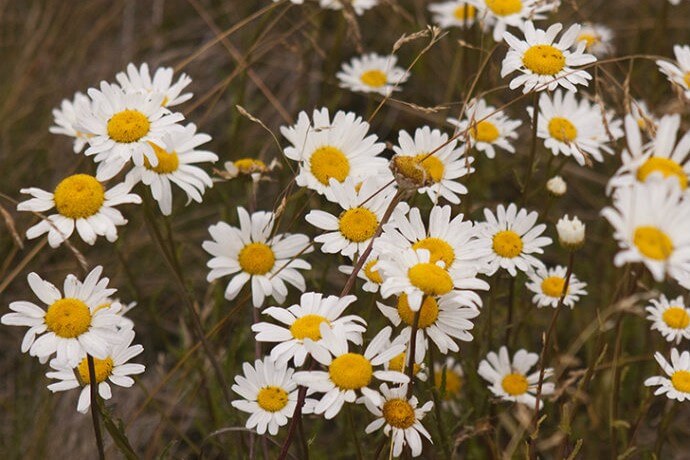What is ox-eye daisy?
Ox-eye daisy (Leucanthemum vulgare) is part of the daisy family (Asteraceae). It is a perennial herb from Europe that spreads mainly by seed but also has shallow creeping roots called rhizomes.
Flower heads have white petals, a yellow centre and grow to 5 centimetres in diameter. The plant can grow to one metre tall and has dark green leaves that progressively decrease in size up the stem.
Mature plants can produce up to 26,000 seeds, which are spread by animals, vehicles and water. Seeds are very long-lived and 80% are viable for 6 years and some up to 39 years.
Why is ox-eye daisy a problem?
Ox-eye daisy is a weed in over 40 countries. In agriculture, the weed is not palatable to cattle and affects pastoral lands by reducing the amount of quality pasture available for grazing. In native landscapes, dense infestations exclude other plant species, leading to soil erosion and depletion of soil organic matter.
View our Flickr gallery for images of ox-eye daisy infestation in Kosciuszko National Park.
Managing ox-eye daisy in National Parks
In New South Wales, ox-eye daisy is present in tableland regions such as the Northern Tablelands, Barrington Tops, the Central Tablelands and the Southern Alps.
Within the Tantangara Area of Kosciuszko National Park, the population has spread rapidly since bushfires in 2007. Ox-eye daisy aggressively invades remote subalpine grasslands, snowgum woodlands and wetlands in Kosciuszko National Park where it is a threat to multiple threatened species.
The National Parks and Wildlife Service (NPWS) works to:
- contain the spread of ox-eye daisy
- protect native species threatened by the weed in Kosciuszko.
Within the core infestation in Kosciuszko National Park, 6 known populations of threatened plants are being protected.
Our program to manage ox-eye daisy also involves:
- research to determine the mechanisms of invasion
- extensive trialling of best practice management techniques
- investigation of methods to assist native plants to compete with ox-eye daisy.
